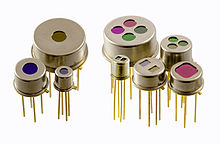Pyroelectric sensor
A pyroelectric sensor , also PIR sensor , English Pyroelectric Infrared Sensor and English Passive Infrared Sensor , is a semiconductor sensor that is used to detect changes in temperature. PIR sensors are based on the eponymous pyroelectricity , a property of some piezoelectric semiconductor crystals. A temperature change ΔT leads to a measurable change in the electrical voltage . Unlike other temperature sensors, PIR sensors do not react to a certain temperature level that is constant over time, but only to changes in temperature.
Applications
PIR sensors are used, among other things, in motion detectors to detect the heat radiation emitted , for example from living beings such as humans, from a few meters away. This enables various actions to be triggered, for example activating lighting or triggering an alarm message. Another application is NDIR gas analysis, as a sensor in IR flame detectors and in low-temperature pyrometers .
construction

The pyroelectric material is a thin (<40 µm) polarized crystal . In order to utilize the pyroelectric effect, electrodes must be applied to the opposite sides . If radiation hits the pyroelectric material, it is absorbed , the resulting temperature difference ΔT causes a change in the polarization of the crystal: The change in thermal radiation causes a change in the electrical potential. With the help of the applied electrodes, the electrical signal can be measured via an amplifier with a high-resistance input - such as a charge amplifier .
Commercially available PIR sensors for motion detectors consist of two adjacent sensor elements with dimensions of 1 mm to 2 mm. The absorption coating used for this has the highest sensitivity in the middle infrared at wavelengths in the range from 5 µm to 14 µm. The sensors are usually housed in a hermetically sealed transistor housing , such as the TO-5 design, together with a preamplifier stage in the form of a junction field effect transistor (JFET).
Simple optics are attached above the active sensor element to improve the detection of changes and the range. A spherically or cylindrically curved Fresnel lens made of plastic is typical . Through the design of this lens, on the one hand, the spatial effective area of the sensor can be influenced and adapted to the respective application; spatial changes of heat sources improved by steeper transitions. The Fresnel lens can be subdivided into individual sector elements and into several partial lenses for fanning out.
The fanning out causes an increased temperature change at the sensor when an object that is warm compared to the background passes through in the detection area of the sensor, since the warm object is initially only detected by one sensor element through the lenses. In the event of further movement, the temperature change is recorded by the second sensor element, while at the same time the first sensor element loses the detection of the object. The two sensor elements are internally connected in such a way that one sensor element generates a positive voltage pulse and the other sensor element generates a negative voltage pulse. As a result of the fanning out, the signal change during movements is roughly doubled through the formation of the difference.
Electrically, PIR sensors in motion detectors have three connections which, like a junction field effect transistor in a gate circuit , are referred to as source , with the function of the output, as drain , for the positive supply connection and gate as ground connection.
With PIR sensors in flame detectors, the flame with a typical flicker frequency between 1 Hz and 5 Hz, as when used in motion detectors, also modulates the radiation flux. In NDIR gas analysis, the modulation takes place either electrically by switching the radiation source on and off, or mechanically. The latter can be implemented by a folding mirror, a folding panel or a chopper . Mechanical modulation is also used in pyrometry .
Since temperature changes are detected with pyroelectric sensors, these sensors are practically independent of the wavelength and can detect radiation starting from deep ultraviolet radiation (wavelength around 100 nm) through the visible and infrared wavelength range up to terahertz radiation with a wavelength of 1 mm. The prerequisite for this is that the pyroelectric crystal has a suitable absorption coating. If materials with a wavelength-dependent degree of absorption are selected for the electrodes, a certain wavelength selectivity is achieved.
literature
- Helmut Budzier, Gerald Gerlach: Thermal Infrared Sensors: Theory, Optimization and Practice . John Wiley & Sons, 2011, ISBN 978-0-470-97675-3 .
Web links
- Comprehensive explanations of the mode of operation and operation of pyroelectric sensors
- Pyroelectric infrared sensors (PDF file) (194 kB)
Individual evidence
- ↑ a b c Pyroelectric Infrared Radial Sensor, Type D203B. (PDF) (No longer available online.) PIR Sensor Co, Ltd., archived from the original on April 21, 2015 ; accessed on January 20, 2016 . Info: The archive link was inserted automatically and has not yet been checked. Please check the original and archive link according to the instructions and then remove this notice.

